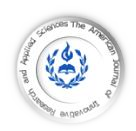
GENERAL INFORMATION
| HOME | ABOUT US | ARCHIVE | AIMS AND SCOP | AUTHORS | REVIEW | SUMIBMIT MANUSCRIPT | EDITORIAL BOARED | PUBLICATION FEE |

| HOME || ABOUT US || ARCHIVES || AIMS AND SCOP || AUTHORS || REVIEW|| SUBMIT MANUSCRIPT || EDITORIAL BOARD |

| Info-AJIRAS-® Journal ISSN 2429-5396 (Online) / Reference CIF/15/0289M |
American Journal of Innovative Research & Applied Sciences

|
American Journal of innovative
Research & Applied Sciences
Research & Applied Sciences
ISSN 2429-5396 (Online)
OCLC Number: 920041286
OCLC Number: 920041286

Authors Contact
*Correspondant author and authors Copyright © 2023:
| Ezzat Harba 1* | and | Nisreen, KHALLOUF 2 |
Affiliation.
1. Tishreen University | Postgraduate Student a Department of Environmental Engineering | Faculty of Civil Engineering | LATTAKIA | SYRIA |
2. Tishreen University | Department of Environmental Engineering | Faculty of Civil Engineering | LATTAKIA | SYRIA |
This article is made freely available as part of this journal's Open Access:
| DOI: 10.5281/zenodo.10041607|
*Correspondant author and authors Copyright © 2023:
| Ezzat Harba 1* | and | Nisreen, KHALLOUF 2 |
Affiliation.
1. Tishreen University | Postgraduate Student a Department of Environmental Engineering | Faculty of Civil Engineering | LATTAKIA | SYRIA |
2. Tishreen University | Department of Environmental Engineering | Faculty of Civil Engineering | LATTAKIA | SYRIA |
This article is made freely available as part of this journal's Open Access:
| DOI: 10.5281/zenodo.10041607|



| ISSN: 2429-5396 (e) | https://www.american-jiras.com | |
| Web Site Form: v 0.1.05 | JF 22 Cours, Wellington le Clairval, Lillebonne | France |
| Web Site Form: v 0.1.05 | JF 22 Cours, Wellington le Clairval, Lillebonne | France |
| OCTOBER | VOLUME 17 | ISSUE N° 4 | 2023 |
| ARTICLES | Am. J. innov. res. appl. sci. Volume 17, Issue - 4 Pages 312-316 (October, 2023)
ABSTRACT
Introduction: This research addresses a concerning issue that emerged in the Shmamis well in early 2018, revealing the presence of cyanide in varying proportions ranging from 0.001 to 0.002 mg/l. The focus is on understanding and mitigating this water quality challenge. Objective: The primary objective of this study is to evaluate the quality of well water in the Shamamis area. This assessment encompasses an examination of the water's suitability for both drinking and irrigation, aligning with Syrian standard specifications. Additionally, the study aims to investigate the spatial contamination levels of groundwater pollutants in the region. Methods: The methodology employed involves the utilization of Kriging to study the spatial contamination levels of groundwater pollutants. This geostatistical interpolation technique is applied to map and analyze the distribution patterns of contaminants, providing valuable insights into the extent of pollution in the study area. Results: The analysis of the well water quality in the Shamamis area revealed the presence of cyanide within the range of 0.001 to 0.002 mg/l. Furthermore, employing Kriging facilitated a spatial assessment of groundwater pollutants, allowing for a comprehensive understanding of contamination levels across the region. Conclusion: In conclusion, this research sheds light on the critical issue of water contamination in the Shamamis well. The findings highlight the presence of cyanide and prompt an evaluation of the water's fitness for consumption and irrigation. The spatial analysis using Kriging contributes to a nuanced understanding of groundwater pollutant distribution. This study underscores the importance of addressing water quality concerns in the Shamamis area, emphasizing the need for remedial measures to safeguard both drinking water and agricultural resources.
Keywords: Shamamis Well; Cyanide Contamination; Water Quality Assessment; Kriging Methodology; Groundwater Pollutants.
Introduction: This research addresses a concerning issue that emerged in the Shmamis well in early 2018, revealing the presence of cyanide in varying proportions ranging from 0.001 to 0.002 mg/l. The focus is on understanding and mitigating this water quality challenge. Objective: The primary objective of this study is to evaluate the quality of well water in the Shamamis area. This assessment encompasses an examination of the water's suitability for both drinking and irrigation, aligning with Syrian standard specifications. Additionally, the study aims to investigate the spatial contamination levels of groundwater pollutants in the region. Methods: The methodology employed involves the utilization of Kriging to study the spatial contamination levels of groundwater pollutants. This geostatistical interpolation technique is applied to map and analyze the distribution patterns of contaminants, providing valuable insights into the extent of pollution in the study area. Results: The analysis of the well water quality in the Shamamis area revealed the presence of cyanide within the range of 0.001 to 0.002 mg/l. Furthermore, employing Kriging facilitated a spatial assessment of groundwater pollutants, allowing for a comprehensive understanding of contamination levels across the region. Conclusion: In conclusion, this research sheds light on the critical issue of water contamination in the Shamamis well. The findings highlight the presence of cyanide and prompt an evaluation of the water's fitness for consumption and irrigation. The spatial analysis using Kriging contributes to a nuanced understanding of groundwater pollutant distribution. This study underscores the importance of addressing water quality concerns in the Shamamis area, emphasizing the need for remedial measures to safeguard both drinking water and agricultural resources.
Keywords: Shamamis Well; Cyanide Contamination; Water Quality Assessment; Kriging Methodology; Groundwater Pollutants.
SPATIAL DISTRIBUTION OF CHLORIDE IONS IN GROUNDWATER USING KRIGING INTERPOLATION: A CASE STUDY IN AL-SHAMMIS, SYRIA
| Ezzat Harba 1* | and | Nisreen, KHALLOUF 2 |. Am. J. innov. res. appl. sci. 2023; 17(4):312-316.
| PDF FULL TEXT | | XML FILE | | https://doi.org/10.5281/zenodo.10041607|
| Ezzat Harba 1* | and | Nisreen, KHALLOUF 2 |. Am. J. innov. res. appl. sci. 2023; 17(4):312-316.
| PDF FULL TEXT | | XML FILE | | https://doi.org/10.5281/zenodo.10041607|